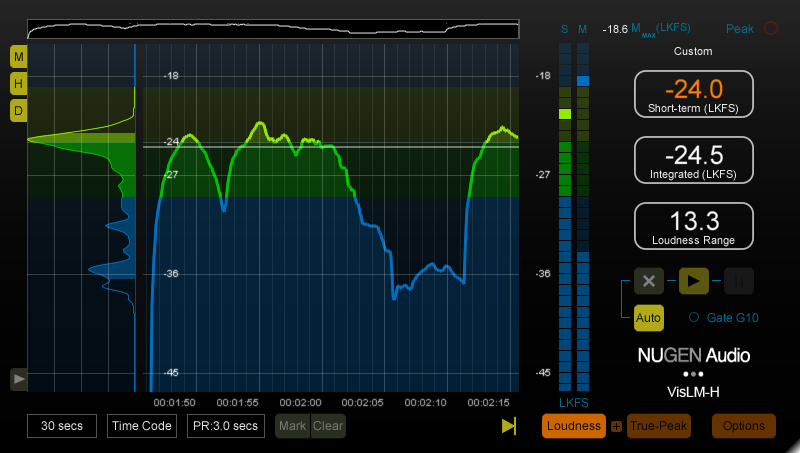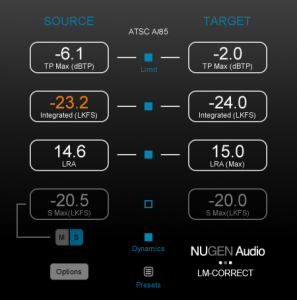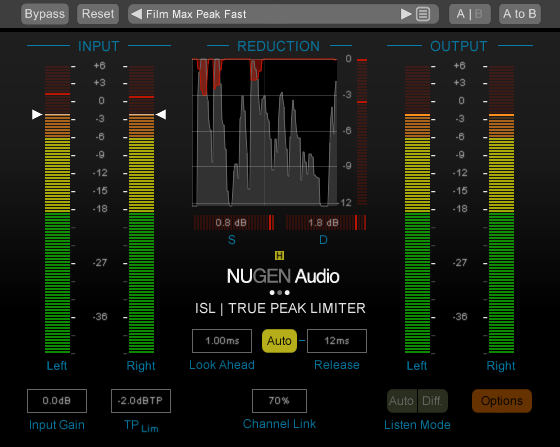Intro: Why LUFS Matter
Audio isn’t judged only by how large the sound waves are - it’s judged by how loud it feels to the listener. That’s where LUFS (Loudness Units relative to Full Scale) come in.
Unlike traditional peak or volume readings, LUFS reflect the way humans actually perceive sound, balancing frequency sensitivity with overall level. It’s the global standard for measuring and controlling loudness across music streaming platforms, podcasts, broadcast television, and film.
If you want your tracks to sound consistent on Spotify, your podcasts to meet industry norms, or your TV mixes to pass compliance checks first time, understanding LUFS is essential.
Already working in broadcast? Take a look at our in-depth Broadcast Loudness guide for detailed specs and workflows.
Note - in some territories, LUFS are referred to as LKFS (Loudness with “K”-weighting relative to Full Scale). The two terms just mean the same thing.
What are LUFS?
Direct answer:
LUFS are a standard for measuring perceived loudness in audio, designed to reflect how humans actually hear sound rather than just signal level.
Traditional meters such as dBFS (decibels relative to full scale) measure the electrical signal strength of audio, with 0 dBFS representing the digital ceiling. But dBFS doesn’t always tell you how loud something feels to a listener.
LUFS solve this problem. They integrate both level and frequency sensitivity into a single loudness measurement, providing a much more realistic picture of the listening experience. That’s why platforms like Spotify, YouTube, and Apple Music - as well as broadcasters worldwide - use LUFS to set delivery standards.
Think of it like this:
- dBFS = how fast the car is going (technical measurement).
- LUFS = how fast it feels when you’re inside the car (human perception).
How are LUFS Measured?
LUFS can be measured in different time windows, depending on what you need to analyse:
- Integrated LUFS - the overall loudness of a full piece of audio. This is the value most often used for compliance and delivery.
- Short-term LUFS - average loudness over three seconds, useful for spotting mid-section shifts.
- Momentary LUFS - a very fast reading (over 400ms) that highlights sudden bursts or peaks.
In practice, you’ll use Integrated LUFS to hit platform targets, while Momentary and Short-term readings help identify problem spots before they cause issues.
Professional metering tools such as NUGEN VisLM display all three in real time, giving you the confidence that your audio is on target from start to finish.
LUFS vs Other Audio Terms
Because LUFS are often mentioned alongside other measurements, it’s important to know the differences:
- LUFS vs dBFS: dBFS measures digital signal level; LUFS measure perceived loudness.
- LUFS vs RMS: RMS was a historic method for estimating loudness but is less accurate than LUFS.
- True Peak (dBTP): Identifies inter-sample peaks that LUFS or dBFS alone might miss.
- Loudness Range (LRA): Shows the difference between the quietest and loudest sections, helping ensure a comfortable dynamic range.
For a deeper dive into these concepts in a broadcast context, see our Broadcast Loudness guide.
How Many LUFS Should My Master Be?
Direct answer:
For music streaming, aim for around -14 to -16 LUFS. For broadcast, the target is typically lower at -23 or -24 LUFS depending on the region.
If you’re mixing music or podcasts, these targets will help your content sound natural and consistent when platforms apply normalisation. For broadcast and film, hitting stricter targets is non-negotiable if you want your content to pass QC.
Remember: don’t squash your mix just to hit the number. Loudness targets are a guideline, but dynamics and True Peak compliance matter just as much.
LUFS Targets by Platform
Every platform sets its own loudness target. Here are the most common ones:
| Platform | Target LUFS | True Peak | Notes | |
|---|---|---|---|---|
| Spotify | -14 LUFS | -1 dBTP | Normalises based on user settings (Normal, Loud, Quiet). | |
| YouTube | -14 LUFS | -1 dBTP | Normalisation varies | not always consistent. |
| Apple Music | -16 LUFS (Stereo) | -1 dBTP | Different spec for Dolby Atmos: -18 LUFS. | |
| Amazon Music | -14 LUFS | -2 dBTP | Consistent with Alexa playback. | |
| Podcasts | -16 LUFS ±1 LU | -1 dBTP | Generally accepted industry norm. | |
| Broadcast (UK/EU) | -23 LUFS ±1 LU | -1 dBTP | See Broadcast Loudness guide for full details. |
Common Mistakes with LUFS
What LUFS does Spotify use?
Spotify normalises to about -14 LUFS in Normal mode, with options for Loud (-11 LUFS) and Quiet (-19 LUFS).
What LUFS does YouTube use?
YouTube typically targets around -14 LUFS, but implementation isn’t always consistent.
Is -14 LUFS good for mastering?
Yes. -14 LUFS is a safe target for most streaming platforms.
Do podcasts need LUFS compliance?
Yes - most platforms accept -16 LUFS ±1 LU as the standard for podcast audio.
How do I measure LUFS?
Use a professional loudness meter such as NUGEN VisLM for real-time monitoring.
Why are LUFS different from dB?
dB measures signal level; LUFS measure perceived loudness, accounting for human hearing.
FAQs About LUFS
Even with the right targets in mind, there are pitfalls to avoid:
- Over-compression - Flattening your mix just to hit LUFS values makes audio lifeless and fatiguing.
- Ignoring True Peak - Passing LUFS doesn’t mean you’re safe from inter-sample clipping.
- Confusing LUFS with dB - They measure different things.
- Relying on platform normalisation - Don’t assume the platform will “fix” everything; it only works cleanly if your mix is already balanced.
Tools like NUGEN ISL (True Peak limiting) and NUGEN LM-Correct (automatic loudness correction) help you stay compliant without compromising sound quality.
Tools to Help You Hit LUFS Targets
NUGEN Audio provides trusted loudness tools used by professionals worldwide:

VisLM - Real-time LUFS metering with Integrated, Short-term and Momentary views.

LM-Correct - Instant loudness fixes and batch processing.

ISL - Precision True Peak limiting to prevent clipping.
Try Loudness Toolkit Free or Speak to an Expert to learn more.
Closing: LUFS in the Bigger Picture
LUFS aren’t about chasing a number - they’re about delivering a consistent, enjoyable listening experience across platforms.
By understanding LUFS and using the right tools, you can create mixes that translate everywhere, from Spotify playlists to Netflix dramas, without stress or guesswork.
For stricter specs and workflows, read our Broadcast Loudness guide.
Written by Dr Paul Tapper, CEO at NUGEN Audio — 20+ years experience in audio-software
Share this